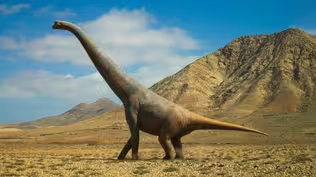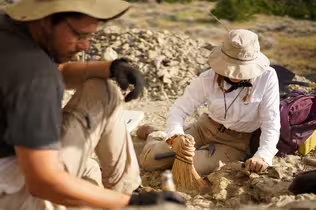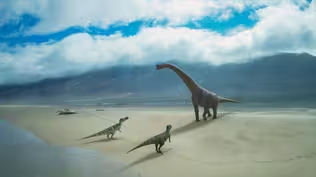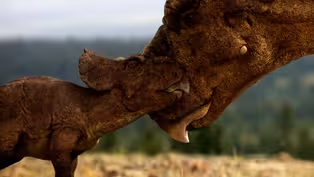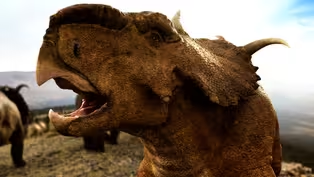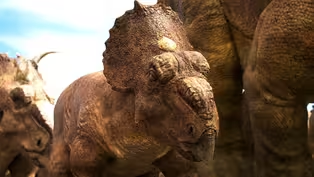
The Journey North
Episode 5 | 54mVideo has Audio Description, Closed Captions
Travel back in time to the dangerous journey of the Pachyrhinosaurus, where survival is at stake.
Travel back in time to the dangerous journey of the Pachyrhinosaurus, where their survival is at stake. During their annual migration hundreds of miles north, they face deadly predators and a storm that threatens their survival.
See all videos with Audio DescriptionADProblems playing video? | Closed Captioning Feedback
Problems playing video? | Closed Captioning Feedback

The Journey North
Episode 5 | 54mVideo has Audio Description, Closed Captions
Travel back in time to the dangerous journey of the Pachyrhinosaurus, where their survival is at stake. During their annual migration hundreds of miles north, they face deadly predators and a storm that threatens their survival.
See all videos with Audio DescriptionADProblems playing video? | Closed Captioning Feedback
How to Watch Walking with Dinosaurs
Walking with Dinosaurs is available to stream on pbs.org and the free PBS App, available on iPhone, Apple TV, Android TV, Android smartphones, Amazon Fire TV, Amazon Fire Tablet, Roku, Samsung Smart TV, and Vizio.
Providing Support for PBS.org
Learn Moreabout PBS online sponsorship♪ [Insects chirping] ♪ Narrator: Over 66 million years ago... [Dinosaur screeches] our world was ruled... [Ferocious growling] by dinosaurs... [Deep growling] [Dinosaur bellowing] [Young dinosaur whines] the largest animals that have ever walked the earth.
[Squealing] ♪ Today, dinosaur experts across the globe are uncovering the bones they left behind... ♪ allowing us to imagine how these extraordinary creatures may have lived... ♪ so that we can tell their stories... [Dinosaur hisses] and they... can walk again.
[Screeching] [Ferocious growling] ♪ Deep in the ancient forests of Alberta Canada... ♪ [Indistinct chatter] a team of dinosaur hunters has come to unearth an astonishing find.
Emily: We've got at least 3 bones sticking out here.
Narrator: Discovered on the edge of a creek are the bones of a Pachyrhinosaurus... ♪ a unique horned dinosaur.
[Tapping with hammer] Lying here is a toddler... Man: It's such a tiny little bone.
Narrator: they call Albie.
I don't think I've seen one that small before.
♪ Narrator: And he's not alone.
He's part of one of the largest dinosaur herds ever found... numbering in the thousands.
We have big adults, we have little babies, we have every age in between.
This was a huge herd of animals.
Narrator: Why so many are buried here is a mystery... ♪ but by studying the bones, we can begin to tell their extraordinary story.
♪ Narrator: 73 million years ago.
♪ What will one day be Northwestern Canada is part of a land mass called Laramidia.
♪ Mountain ranges extend for thousands of miles, towering over a wilderness of dense forested valleys.
[Birds chirping] [Bellowing] This vast terrain is roamed by gigantic groups of plant-eating dinosaurs... ♪ that like today's caribou or elk migrate each season.
[Bellowing] ♪ And by far the largest of these prehistoric herds... ♪ are the Pachyrhinosaurus.
♪ [Low growl] A close relative of Triceratops, these social dinosaurs have spent the winter in the south.
[Growling] ♪ But with the land now almost completely bare... ♪ staying here would mean starvation.
♪ So the herd is setting out on an epic 400-mile trek north where by summer the vegetation should be abundant.
[Low growl] [Snorting huff] It will be a grueling journey, especially if you're one of the youngest... ♪ like Albie.
♪ At less than a year old, he's under two feet tall... ♪ which makes keeping up... ♪ a bit of a challenge.
♪ [Albie squeaks] Even so, he must stay close to his mother... [Albie whines] [Soft bellowing] because the herd aren't the only ones that are hungry.
♪ Following in their wake, Azhdarchid pterosaur.
♪ With a 20-foot wingspan and estimated speed of 60 miles an hour... [Deep rumbling call] a young Pachyrhinosaurus makes for an easy target.
♪ [Low growl] [Ferocious growling] [Whimpers] ♪ [Growls] ♪ A close call.
♪ But it's only the start of the challenges they will face ♪ as the search for food takes them across the prehistoric wilderness.
♪ [Faint tapping with hammer] ♪ [Indistinct chatter] ♪ 73 million years later... the work to understand this enormous herd is well underway.
[Indistinct chatter] There's a pretty large cluster of bones there.
Man: Seem to belong potentially to a large animal.
Narrator: It's a painstaking process led by Emily Bamforth, who has spent 15 years studying Canadian dinosaurs and is piecing together the journey that bought the Pachyrhinosaurus here.
♪ And in one corner of the site... Emily: Is that a little vertebra?
Narrator: something has caught her eye.
Emily: Oh man, that is so little.
Man: Right in this corner.
Baby bone, baby bone, baby bone.
Narrator: Emerging from the rock are not just Albie's bones but those of other youngsters.
♪ And comparing their size... Man: Juvenile vertebra is just under 3 inches, that's another really young animal.
Narrator: reveals something significant.
Emily: All of the juveniles here, these are all about a year old.
Man: Wow.
Narrator: They're all the same age.
Born around the same time.
Emily: They have to have been born on the previous summer's migration.
That to me is interesting.
♪ Narrator: Emily's findings suggest the herd was making its yearly journey for more than just food.
[Albie whines] ♪ They were returning to their summer nesting ground.
♪ And joining them are thousands more ♪ as every Pachyrhinosaurus on the continent heads north... [Deep, guttural growl] ♪ merging into one of the greatest spectacles of the prehistoric world.
♪ [Snorting huff] [Deep bellowing] ♪ But with such a colossal gathering... ♪ tension is in the air.
[Deep growling] ♪ Breeding season is upon them, so bulls in the herd must compete for their right to mate... [Deep growling] from old veterans... [Ferocious growling] ♪ to their younger rivals.
[Huffing] [Growling] And there's only one way to prove their worth.
[Growls] ♪ [Deep growl] ♪ In a contest as brutal as this... [Albie whining] Albie's mother must keep a watchful eye.
♪ Making sure he isn't trampled or even killed.
[Deep, guttural growling] ♪ But as one of the youngest, curiosity gets the better of him.
[Albie whining] ♪ [Growls and huffs] Using their thick armored noses... ♪ each male seeks to deliver a bone-shattering blow.
♪ [Guttural growling] And the ultimate target... [Rumbles] is behind the other's horned armor.
♪ [Strained growl] The young rival... [Ferocious growling] gains the upper hand.
♪ [Wailing moan] ♪ Emily: That is weird.
Narrator: At the dig site, uncovering what appears to be the rib of a huge bull... Man: It seems like the rib trends this way but then starts back up that way.
Narrator: Emily and her teammate Max Scott are finding evidence of a punishing injury.
♪ Emily: This part of the rib and that part of the rib are slightly offset, so it looks as if this rib has actually been broken in the middle.
Yeah, so it seems like it was almost shoved off to one side.
Narrator: The rib is twice as thick as a bear's.
The fact it snapped means this bull suffered a potentially fatal blow.
It would have to be a considerable impact, so either the opponent striking it really hard or when it fell sideways.
Whatever happened, it would have been very painful.
Like, with an impact this size, the rib could puncture the lung.
♪ Narrator: But examining the fossil reveals something curious.
Max: It's really bulgy there.
Emily: So, I think that's a bone callous.
Narrator: Bone callouses form over a break as part of the healing process.
The bone has broken and has actually shifted sideways while the animal was alive, and this big bony bump healed around it and set it.
would have been very painful for the animal, but they would have survived it.
Max: It's really quite an impressive feat, really shows just how tough he really was.
♪ Narrator: The healed injury is important evidence.
[Hoarse breathing] It suggests the strongest bulls in the herd were capable of taking severe punishment... [Huffs sharply] [Deep bellowing] and getting back on their feet.
♪ [Ferocious roaring] ♪ [Bellowing] ♪ [Loud thud] An ability they need... [Ferocious growl] to come out on top.
[Weak growl] [Ferocious growling] ♪ [Groaning] With a winner firmly established... [Guttural growling] the monumental herd continues its journey to the fertile north.
♪ [Albie whining] But though the fighting may have subsided, for Albie the danger is only just beginning.
[Albie whining] ♪ [Albie whines] In the chaos, he has become separated from his mother and lost in the crowd.
♪ In a herd of this magnitude, finding her won't be easy.
♪ [Albie whines] ♪ [Happer tapping] Emily: Look at this.
Narrator: But at the dig site, evidence is emerging that suggests every one of this enormous herd may have looked unique.
Emily: It looks like it's relatively complete, and this is a big one.
Narrator: Buried in the rock is an incredibly rare find, an adult's bony headdress known as the frill.
Max: This might be the front and that's the back.
Emily: Yeah, that's what I was thinking too.
So, like that--the nose is over here somewhere, and, like, the body is back there.
I don't think I have ever seen any where one of the middle horns is going the opposite direction of the other.
Narrator: Given this frill's highly unusual shape, Emily is keen to compare it with others found in the creek.
♪ Emily: So, on this individual, the horns that stick out the side of the frill, they're straight whereas this one is interesting.
This is an asymmetrical frill, so this horn is straight, and that one is curled.
♪ Narrator: Each frill is distinct from the other.
Emily: It is very striking that these frills, despite being from almost exactly the same place in the bone bed, from the same community of animals, like, they're still very different from one another.
Narrator: Over 20 frills have now been found at the site, and incredibly, no two have ever looked the same, leading the team to think their variation served a crucial purpose.
Based on the differences in these frill horns, it would be very easy for the individuals to recognize each other.
Yeah, in a herd environment like this, it is very important to be able to recognize your friends and your family easily.
♪ [Grumbling] Narrator: With every member of the herd displaying their own unique frill... [Guttural cry] it could help a youngster like Albie pick out his mother from the masses... ♪ by scanning each and every one for her familiar features.
♪ [Groaning] But in the sea of Pachyrhinosaurus streaming past... ♪ she is still nowhere to be seen.
♪ [Guttural cry] [Whining] ♪ Without his mother's protection, he has little chance of surviving the long journey... [Whining] alone.
♪ [Wind blowing] [Guttural crying] ♪ [Growl, twig snaps] Until... [Deep growl] finally... the distinctive outline of a frill... [Growling] he knows better than any other... [Grumbles] [Deep growling] and a mother relieved to have found her young.
♪ [Soft rumbling] ♪ [Low, throaty growling] But though reunited, there is much danger still ahead.
♪ [Boat engine roaring] ♪ 30 miles from the main dig site... ♪ Emily and paleontologist Jackson Sweeder have traveled to the edge of a forest.
♪ Here ancient footprints follow the herd's route.
Emily: That's a toe... Jackson: Yeah.
and then that's a toe.
Missing the third one here.
See it again?
Missing that toe over there.
Jackson: Missing.
Emily: Yeah.
Once you get your eye in, they're actually all over the place.
They're everywhere.
Narrator: And one stands out from all the others.
Emily: Clearly a carnivore.
And you can even see the claws.
That's a point.
A big animal, as well.
What, 8 meters?
Yeah.
♪ Narrator: To confirm the identity of this 26-foot-long predator, Emily and Jackson use liquid rubber to make a cast that reveals how it moved.
♪ Emily: The back of the track is shallower than these toes here.
The toes are super deep.
So, it's moving on the front of its feet, like sort of like fast animals today like cheetahs would do.
Definitely wider than it is deep, so it can move side to side if it has to.
So probably a very agile animal, as well.
Narrator: This kind of speed and agility belongs to only one predator in the region... a terrifying relative of T. rex that hunted in packs.
Jackson: Those Pachyrhinosaurus definitely would have had to worry about this animal.
Yeah.
It's very efficient at moving long distances, it could follow them for miles and just wait for an opportunity.
♪ Narrator: The Gorgosaurus.
[Grumbling] ♪ With exceptional hearing... [Sniffing] and a sense of smell more powerful than any other dinosaur... [Howling] it's thought they could track their prey from up to 10 miles away... ♪ allowing them to ambush at a moment of their choosing.
♪ [Bleating, huffing] ♪ [Deep grumbling] Unaware of the approaching threat, the herd moves deeper into the forest... ♪ surrounded by its narrow pathways.
♪ An attack could come from any direction.
♪ [Twig snaps] [Albie whining] ♪ But there is no sign of the danger yet.
♪ [Snoring] [Distant bellowing] ♪ The sound of intruders draws Albie away from the herd... ♪ but these aren't the stealthy footsteps of a Gorgosaurus.
[Cracking] Something else is closing in.
♪ Emily: Take care with your footing.
♪ Narrator: Journeying along the herd's migration route, Emily and her team have discovered evidence of another mysterious dinosaur, which has emerged on the edge of what is now a river.
♪ Emily: Ooh!
Man: Yeah, it's a little chilly.
Emily: Oh yeah, it's cold.
♪ Narrator: Exposed by receding water, its fossilized remains are all along the riverbank.
Man: It's huge.
Woman: It's just packed with stuff.
It's crazy that it's just kind of sitting out here on the surface.
Man, that's big.
Woman: It definitely seems to be in a layer here.
Whatever this is.
♪ Narrator: And it isn't long before the team hits the jackpot.
Oh, my goodness.
♪ Emily: That's a huge bone.
Narrator: Buried in the rock is part of its gigantic hind limb.
Emily: Do you have a measuring tape?
Woman: Yeah, let's just take a quick measurement.
Narrator: They can use this to estimate the animal's full size.
Woman: It's really long.
Even if it's only to there, that's still definitely over a meter.
Yeah.
I would say with legs like this, it's probably about the size of a school bus, around 9 meters long or so.
That's huge.
There's not much that gets bigger than this.
Narrator: Even larger than a Gorgosaurus, its 30-foot length means it could be only one dinosaur... [Bird calling] and the forest is the ideal place for it to find its next meal.
[Wood cracking] ♪ [Crunching] But this isn't a killer.
♪ It's an Edmontosaurus... [Ground rumbles] [Crunch] which along with its herd is on the same migration north.
[Bellowing] As plant eaters, they pose no threat... but these 6-ton giants... [Wood cracks] make a lot of noise.
[Branches snapping] [Branches snap echoing] [Growling in distance] ♪ And it's drawing the pack of hungry Gorgosaurus straight towards them.
[Distant growl] [Nasal bellowing] ♪ [Guttural growling] [Low growling] ♪ [Huffing] [Nasal bellowing] [Ferocious growl] [Distant growling and crackling] ♪ For Albie, it's another narrow escape.
♪ And as the herd pushes on, the Aurora lighting up the skies above is a sign their journey north is almost over.
♪ [Birds chirping] ♪ Emily: Do you have a chisel?
Jackson: Yep.
Narrator: Not far from the main dig site, Emily and Jackson are finding evidence of exactly what the herd was looking for.
Jackson: That's huge.
Emily: Yeah.
Narrator: An abundance of food just waiting to be discovered.
Emily: There's so many different plants here, just on this one slab not just big leaves like this.
Also, lots of flowering plants, as well.
All of these things would be really great food for Pachyrhinosaurus.
Narrator: The plants in these rocks would have flourished in the summer in time for the herd's nesting season.
Emily: Looking at all of these plants, there's enough food for the adults and the juveniles.
Jackson: More than enough to draw the Pachyrhinosaurus up here.
Emily: And when the babies hatch, there's food for the babies, as well.
Narrator: This place would mark the end of the herd's long migration.
♪ A haven where they could settle and begin to nest.
[Birds chirping] [Guttural growling distantly] ♪ [Thundering footsteps] ♪ Narrator: But while the exhausting 400-mile walk may finally be over... ♪ there is one problem they haven't left behind.
[Distant growl] [Hissing] The Gorgosaurus have stayed close.
[Guttural grunt] ♪ [Guttural bellowing] And with the Pachyrhinosaurus backed up against the river... ♪ it gives these ferocious predators the perfect opportunity to pick off one of the herd's more vulnerable members.
[Nasal snorting] ♪ [Hissing] [Albie whining] [Ferocious growl] [Albie whining] But Albie is not alone.
[Guttural growling] His mother's instinct is to fight.
[Rumbling] [Snarling] [Guttural growling] But their confrontation is about to pale into insignificance.
[Thunder rumbling] Both predator... and prey... face a far greater threat.
[Thunder cracking] [Low growling] ♪ Investigating what happened at the end of the herd's journey... Man: OK, move to the next point.
Narrator: and why so many are buried here, Emily's team is mapping the bones.
Emily: Obviously got a pretty large cluster in that corner.
Jackson: Those two are so close together.
Woman: They are so, so close together, man.
It's pretty much right up against.
Jackson: Yeah.
Man: All right.
Jackson: Let's go.
[Groans] Narrator: They can then scan to create a full 3D model of the site.
♪ It's coming through really well.
Yeah, you can see the patterning on the surface of the bone.
Narrator: The imaging allows them to see exactly how the fossils are laid out.
You can see how the bones are stacked on top of each other.
Everything here is bone.
There's actually very little rock in between there.
It's just a solid mass of bone material.
Max: You can kind of see ribs of just about every size just even in this one pocket here.
And they're clearly all from different individuals because they're all different sizes.
Narrator: The bones of young and old are jumbled together.
♪ And there's even more in the ground than the team first realized.
Emily: You think of the sheer density of bones in just this little area that we've scanned, and then put that together with the grid mapping.
Woman: Perfect.
Emily: There's something like 100 to 300 bones per square meter, and then we know the bone bed goes back into the hill for another kilometer.
Man: Good for now.
Narrator: Their findings bring the estimate of Pachyrhinosaurus preserved at the site into the tens of thousands.
To have died in such large numbers, they must have faced a catastrophic event.
[Saw motor running] ♪ Looking for answers, Emily and Max cut deep into the rock that encases the herd.
♪ Emily: Tilt it up.
I just want to take look at the cross section.
Narrator: It reveals a vital clue.
Emily: Look at this piece.
All of that black, it's plant material that's been shredded.
Something has picked up the mud and has, like, twisted it with enough energy to move the amount of material and to shred the plants up like that, and that's right in with the bones.
And all these swirls in here, something dramatic has happened that's involved water.
You can see where it's actually cut down into the rock underneath it like a fossilized wave, and so this was a huge energy event.
Narrator: The evidence all points to one thing.
[Thunder cracking] ♪ A devastating flash flood... [Guttural growling] [Albie whines] [Thunder clapping] triggered by huge storms, raging over the mountains.
[Rain pattering] [Thunder cracking] Water cascades into the valley... swelling into an unstoppable current... that destroys everything in its path.
♪ [Ground rumbling] [Guttural cry] ♪ [Albie whimpering] As the floodwaters near... [Thunder clapping] the herd begins to panic.
♪ Mother and child... waiting by each other's side.
[Albie whines] [Thunder clapping] [Nasal snort] [Water approaching] ♪ Little could have withstood a flood on this scale.
♪ And for Albie and much of his herd, it marks a tragic end.
♪ But despite the devastation, this was perhaps not the end for them all.
♪ Just under 30 miles north of the main dig site... Emily: Come on, Esther.
Narrator: Emily and Jackson have traveled out into the hills of Canada's grand prairie to investigate an incredible find.
♪ Emily: So, there's 3 sites that have been identified.
Jackson: Right.
I think that's one of them uh, and the other two, I think there's one over there, and there's one behind us, as well.
♪ Narrator: Across the area, a series of fossils has been unearthed that point to an extraordinary possibility.
Jackson: Looks like a toe bone but absolutely tiny.
Emily: That also is from a very, very small animal.
Like that to me looks like it's from an animal that has either just hatched, like a hatchling or is actually still in the egg, an embryonic dinosaur.
An animal this size has to have been born here.
Narrator: The young belong to both Pachyrhinosaurus and Edmontosaurus.
Dinosaurs that were heading for the same destination.
To me it's not a coincidence that they're both here.
We're only 30 or 40 kilometers away from the site of the flood, so surviving animals could eventually have made their way here.
This might have been the nesting ground for both of these mega herbivores after the flood.
♪ Narrator: Emily and Jackson are continuing to look for more evidence... ♪ but this remarkable discovery [Pterosaur screeching] means that maybe... ♪ despite all the odds, some of the herd did survive... ♪ continuing on to find another place to nest.
♪ [Growling] ♪ Survivors... [Growls] with a chance to pave the way... ♪ for the next generation... to thrive... ♪ so that one day... ♪ their herd can rise again.
[Roaring] ♪ [Metallic tapping against rock] In the wilderness of Northern Alberta, scientists are excavating the bones of the unique horned dinosaur Pachyrhinosaurus... ♪ in an effort to do something truly unexpected, reconstruct their brains.
Surveys of the ancient rock in Pipestone Creek show it's home to one of the biggest dinosaur herds ever found.
With the Pachyrhinosaurus living in colossal groups.
Emily: It could be literally hundreds of thousands, maybe even millions of bones.
And so, we estimate the size of the Pipestone Creek herd at 40,000 animals.
Narrator: So what enabled these 1.5-ton herbivores to live in such enormous numbers 73 million years ago?
♪ [Birds chirping] To find out, paleontologist Emily Bamforth wants to get inside their heads.
Emily: Even though the brain is long gone, if we look into the skulls of these long extinct animals, it could better help us understand what the structure of herding animal brains actually looks like and how that might have informed the behavior of the animal.
Narrator: Pachyrhinosaurus brains were protected by a half-inch-thick solid shell known as the brain case.
♪ Today Emily is bringing one of these brain cases, still inside a skull, to a specialized imaging facility in Edmonton, Alberta.
She's investigating a theory that the brains of herding dinosaurs would be physically different to those that were on their own because of the demands of living in a group.
Emily: Herding dinosaurs versus solitary animals might have various parts of the brain that are developed differently because they need to focus on certain behaviors over others.
Narrator: So to understand more, she's using a CT scanner normally reserved for human patients, to create x-ray images of the shape inside the braincase.
Emily: CT scanning gives us a really clear idea of what the shape of the internal bones are.
The brains themselves are not preserved.
What we get is the space in the skull where the brain was.
♪ Narrator: Once the scan is completed, scientists Max Scott and Natalia Usachenko can use the images to reconstruct the brain's shape.
♪ It's a painstaking process, tracing the shape slice by slice, to build a full 3D model.
Max: You can see the brain structures.
There's a lot of density in here.
Just a lot of really great things.
Narrator: It paints a clear picture of how Pachyrhinosaurus brains were adapted to life in the herd.
Emily: They have structures in their brains that are founded in herding animals today.
Things they probably would have used for individual identification.
Narrator: Pachyrhinosaurus herds are thought to have consisted of thousands of smaller family groups, so they had to be able to spot each other in a crowd.
And the scan suggests parts of their brain were specialized to identify each individual's unique frill.
Natalia: There's structures, and they're closely associated with pattern recognition.
Emily: Every frill is different and parts of the Pachyrhinosaurus brain are better developed, so they can recognize each pattern.
At a distance, they could see who was who.
Narrator: But the results also show their brains were adapted for more than finding friends.
They were built for dealing with foes.
Living in large social groups meant that the males had to fight for their pick of the mates.
And Pachyrhinosaurus brains appear to be wired for handling these one-on-one battles.
Natalia: The vestibular apparatus is rather enlarged, and it's what strongly controls that eye stabilization, so they're able to track movements around them.
Emily: The organ that is used for balance seems to be more developed in Pachyrhinosaurus.
Having good balance, uh, would be a better way to withstand individual to individual combat which would be more common in a herd environment.
[Deep growl] Narrator: For Emily and her team, this cutting-edge research has given them new insight into these unique dinosaurs.
And with more discoveries being made all the time, it's revealing an unprecedented picture of what life was like in one of the biggest dinosaur herds in Earth's history.
♪ Next time... One of the largest dinosaurs ever to walk the Earth... goes looking for love.
[Growling] A quest... that will become a life-and-death struggle.
[Snarls] ♪
Baby Pachyrhinosaurus Struggles to Survive in the Wilderness
Video has Closed Captions
Clip: Ep5 | 2m 39s | Staying close to the herd is the only chance for baby Pachyrhinosaurus to survive danger. (2m 39s)
Brutal Pachyrhinosaurus Battle
Video has Closed Captions
Clip: Ep5 | 3m 7s | A fight breaks out amongst the mega herd of Pachyrhinosaurus gathering to migrate north (3m 7s)
Video has Closed Captions
Preview: Ep5 | 30s | Travel back in time to the dangerous journey of the Pachyrhinosaurus, where survival is at stake. (30s)
Providing Support for PBS.org
Learn Moreabout PBS online sponsorship
- Science and Nature

Explore scientific discoveries on television's most acclaimed science documentary series.

- Science and Nature

Capturing the splendor of the natural world, from the African plains to the Antarctic ice.












Support for PBS provided by:

